MO09409: Operations, Supply Chain & Marketing Management Analysis
VerifiedAdded on 2023/06/13
|12
|2578
|126
Report
AI Summary
This report provides an analysis of operations, supply chain, and marketing management strategies, focusing on Pars Food Limited and Preston Plant. For Pars Food, the report identifies challenges such as the lack of standardized processes and reliance on external transport for raw materials, recommending the implementation of structured procedures and internalizing transportation. Regarding supply chain management, the report suggests incorporating smart connections and technology to streamline the sales process. For marketing management, the report advocates for the use of online platforms to enhance effectiveness and speed. The report also examines the turnaround strategies at Preston Plant, emphasizing employee motivation, improved production speeds, and product quality enhancements. Finally, it discusses Domino's Pizza's marketing strategies, including customer relations, promotional campaigns, and product variation, while recommending the adoption of online platforms for broader reach and cost-effectiveness. Desklib offers a wide array of study resources, including past papers and solved assignments.
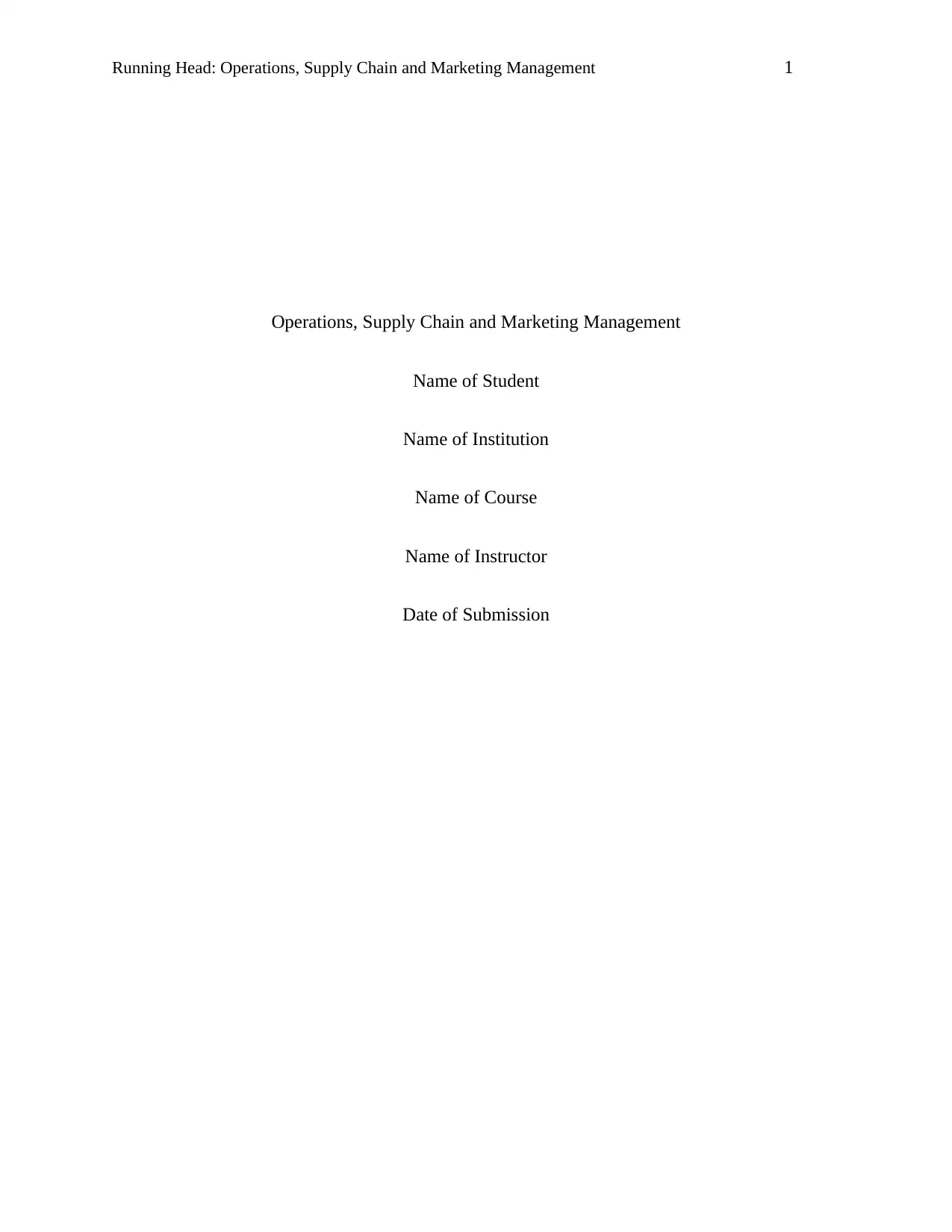
Running Head: Operations, Supply Chain and Marketing Management 1
Operations, Supply Chain and Marketing Management
Name of Student
Name of Institution
Name of Course
Name of Instructor
Date of Submission
Operations, Supply Chain and Marketing Management
Name of Student
Name of Institution
Name of Course
Name of Instructor
Date of Submission
Paraphrase This Document
Need a fresh take? Get an instant paraphrase of this document with our AI Paraphraser
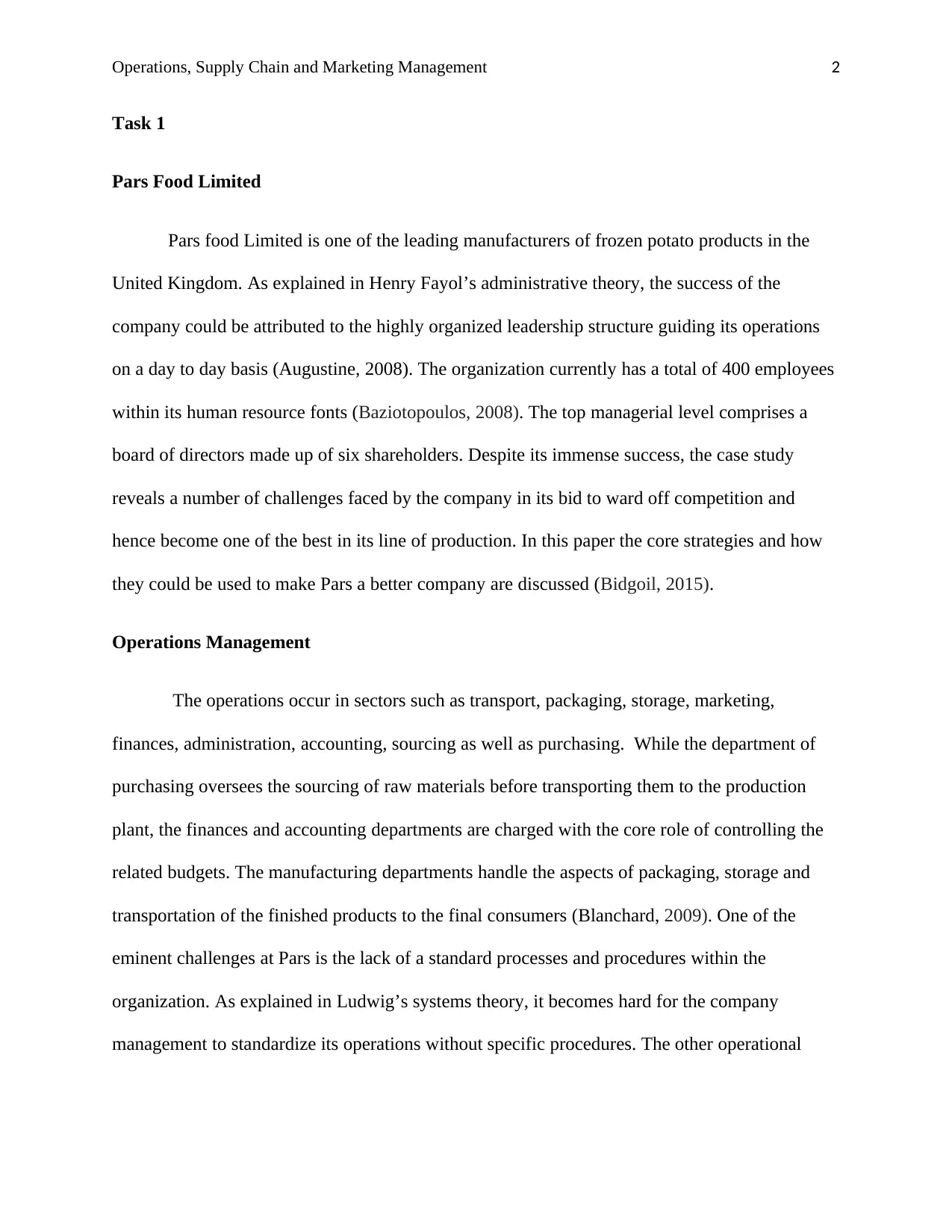
Operations, Supply Chain and Marketing Management 2
Task 1
Pars Food Limited
Pars food Limited is one of the leading manufacturers of frozen potato products in the
United Kingdom. As explained in Henry Fayol’s administrative theory, the success of the
company could be attributed to the highly organized leadership structure guiding its operations
on a day to day basis (Augustine, 2008). The organization currently has a total of 400 employees
within its human resource fonts (Baziotopoulos, 2008). The top managerial level comprises a
board of directors made up of six shareholders. Despite its immense success, the case study
reveals a number of challenges faced by the company in its bid to ward off competition and
hence become one of the best in its line of production. In this paper the core strategies and how
they could be used to make Pars a better company are discussed (Bidgoil, 2015).
Operations Management
The operations occur in sectors such as transport, packaging, storage, marketing,
finances, administration, accounting, sourcing as well as purchasing. While the department of
purchasing oversees the sourcing of raw materials before transporting them to the production
plant, the finances and accounting departments are charged with the core role of controlling the
related budgets. The manufacturing departments handle the aspects of packaging, storage and
transportation of the finished products to the final consumers (Blanchard, 2009). One of the
eminent challenges at Pars is the lack of a standard processes and procedures within the
organization. As explained in Ludwig’s systems theory, it becomes hard for the company
management to standardize its operations without specific procedures. The other operational
Task 1
Pars Food Limited
Pars food Limited is one of the leading manufacturers of frozen potato products in the
United Kingdom. As explained in Henry Fayol’s administrative theory, the success of the
company could be attributed to the highly organized leadership structure guiding its operations
on a day to day basis (Augustine, 2008). The organization currently has a total of 400 employees
within its human resource fonts (Baziotopoulos, 2008). The top managerial level comprises a
board of directors made up of six shareholders. Despite its immense success, the case study
reveals a number of challenges faced by the company in its bid to ward off competition and
hence become one of the best in its line of production. In this paper the core strategies and how
they could be used to make Pars a better company are discussed (Bidgoil, 2015).
Operations Management
The operations occur in sectors such as transport, packaging, storage, marketing,
finances, administration, accounting, sourcing as well as purchasing. While the department of
purchasing oversees the sourcing of raw materials before transporting them to the production
plant, the finances and accounting departments are charged with the core role of controlling the
related budgets. The manufacturing departments handle the aspects of packaging, storage and
transportation of the finished products to the final consumers (Blanchard, 2009). One of the
eminent challenges at Pars is the lack of a standard processes and procedures within the
organization. As explained in Ludwig’s systems theory, it becomes hard for the company
management to standardize its operations without specific procedures. The other operational
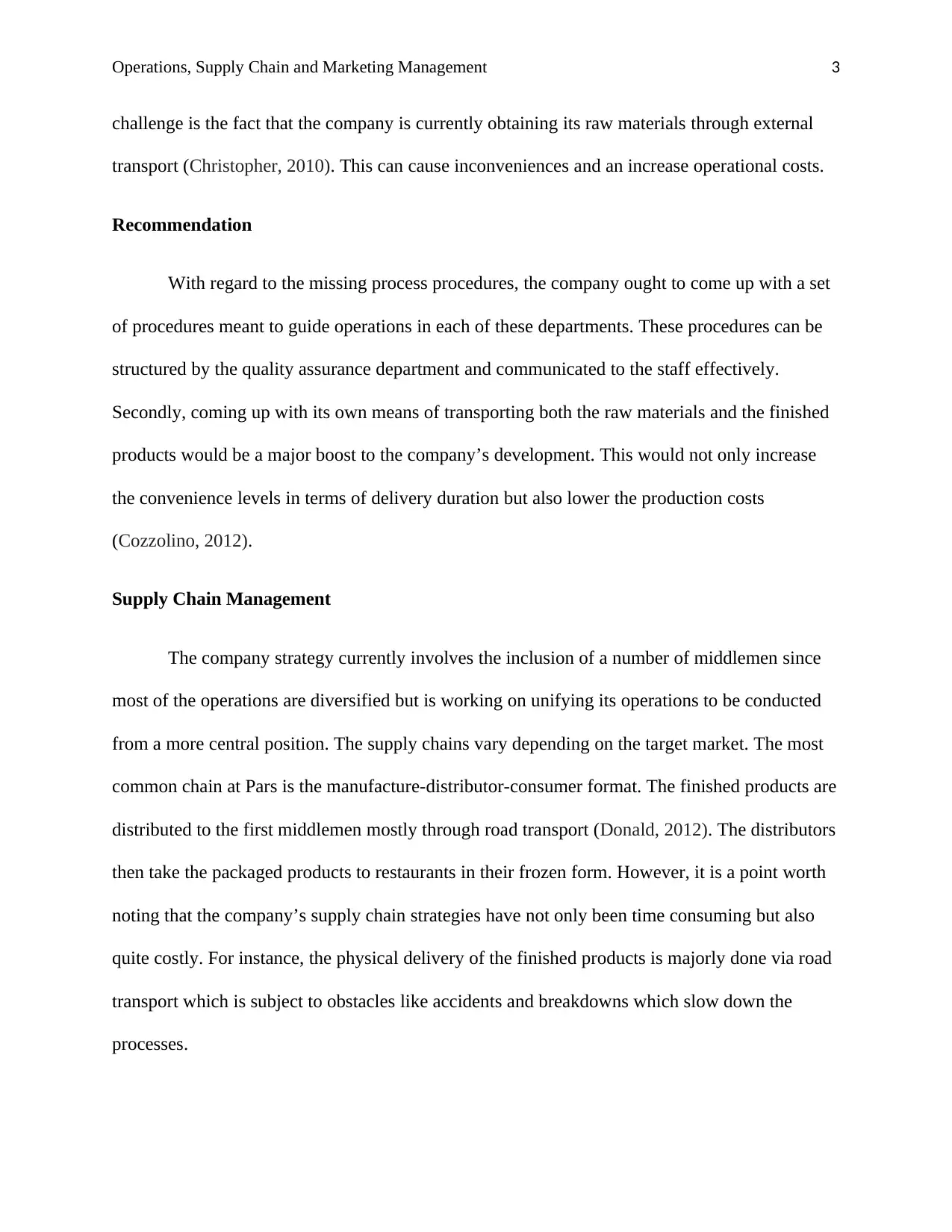
Operations, Supply Chain and Marketing Management 3
challenge is the fact that the company is currently obtaining its raw materials through external
transport (Christopher, 2010). This can cause inconveniences and an increase operational costs.
Recommendation
With regard to the missing process procedures, the company ought to come up with a set
of procedures meant to guide operations in each of these departments. These procedures can be
structured by the quality assurance department and communicated to the staff effectively.
Secondly, coming up with its own means of transporting both the raw materials and the finished
products would be a major boost to the company’s development. This would not only increase
the convenience levels in terms of delivery duration but also lower the production costs
(Cozzolino, 2012).
Supply Chain Management
The company strategy currently involves the inclusion of a number of middlemen since
most of the operations are diversified but is working on unifying its operations to be conducted
from a more central position. The supply chains vary depending on the target market. The most
common chain at Pars is the manufacture-distributor-consumer format. The finished products are
distributed to the first middlemen mostly through road transport (Donald, 2012). The distributors
then take the packaged products to restaurants in their frozen form. However, it is a point worth
noting that the company’s supply chain strategies have not only been time consuming but also
quite costly. For instance, the physical delivery of the finished products is majorly done via road
transport which is subject to obstacles like accidents and breakdowns which slow down the
processes.
challenge is the fact that the company is currently obtaining its raw materials through external
transport (Christopher, 2010). This can cause inconveniences and an increase operational costs.
Recommendation
With regard to the missing process procedures, the company ought to come up with a set
of procedures meant to guide operations in each of these departments. These procedures can be
structured by the quality assurance department and communicated to the staff effectively.
Secondly, coming up with its own means of transporting both the raw materials and the finished
products would be a major boost to the company’s development. This would not only increase
the convenience levels in terms of delivery duration but also lower the production costs
(Cozzolino, 2012).
Supply Chain Management
The company strategy currently involves the inclusion of a number of middlemen since
most of the operations are diversified but is working on unifying its operations to be conducted
from a more central position. The supply chains vary depending on the target market. The most
common chain at Pars is the manufacture-distributor-consumer format. The finished products are
distributed to the first middlemen mostly through road transport (Donald, 2012). The distributors
then take the packaged products to restaurants in their frozen form. However, it is a point worth
noting that the company’s supply chain strategies have not only been time consuming but also
quite costly. For instance, the physical delivery of the finished products is majorly done via road
transport which is subject to obstacles like accidents and breakdowns which slow down the
processes.
⊘ This is a preview!⊘
Do you want full access?
Subscribe today to unlock all pages.

Trusted by 1+ million students worldwide
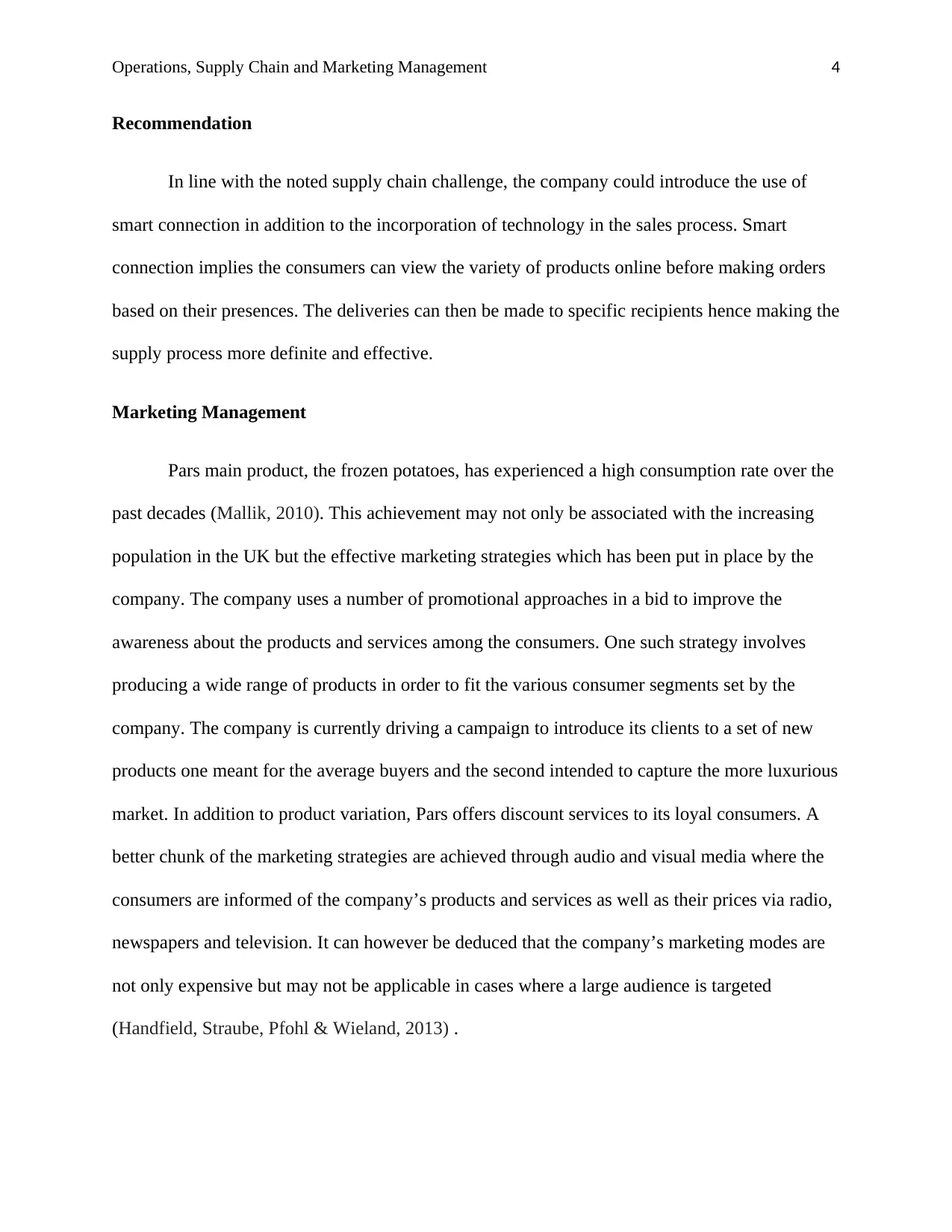
Operations, Supply Chain and Marketing Management 4
Recommendation
In line with the noted supply chain challenge, the company could introduce the use of
smart connection in addition to the incorporation of technology in the sales process. Smart
connection implies the consumers can view the variety of products online before making orders
based on their presences. The deliveries can then be made to specific recipients hence making the
supply process more definite and effective.
Marketing Management
Pars main product, the frozen potatoes, has experienced a high consumption rate over the
past decades (Mallik, 2010). This achievement may not only be associated with the increasing
population in the UK but the effective marketing strategies which has been put in place by the
company. The company uses a number of promotional approaches in a bid to improve the
awareness about the products and services among the consumers. One such strategy involves
producing a wide range of products in order to fit the various consumer segments set by the
company. The company is currently driving a campaign to introduce its clients to a set of new
products one meant for the average buyers and the second intended to capture the more luxurious
market. In addition to product variation, Pars offers discount services to its loyal consumers. A
better chunk of the marketing strategies are achieved through audio and visual media where the
consumers are informed of the company’s products and services as well as their prices via radio,
newspapers and television. It can however be deduced that the company’s marketing modes are
not only expensive but may not be applicable in cases where a large audience is targeted
(Handfield, Straube, Pfohl & Wieland, 2013) .
Recommendation
In line with the noted supply chain challenge, the company could introduce the use of
smart connection in addition to the incorporation of technology in the sales process. Smart
connection implies the consumers can view the variety of products online before making orders
based on their presences. The deliveries can then be made to specific recipients hence making the
supply process more definite and effective.
Marketing Management
Pars main product, the frozen potatoes, has experienced a high consumption rate over the
past decades (Mallik, 2010). This achievement may not only be associated with the increasing
population in the UK but the effective marketing strategies which has been put in place by the
company. The company uses a number of promotional approaches in a bid to improve the
awareness about the products and services among the consumers. One such strategy involves
producing a wide range of products in order to fit the various consumer segments set by the
company. The company is currently driving a campaign to introduce its clients to a set of new
products one meant for the average buyers and the second intended to capture the more luxurious
market. In addition to product variation, Pars offers discount services to its loyal consumers. A
better chunk of the marketing strategies are achieved through audio and visual media where the
consumers are informed of the company’s products and services as well as their prices via radio,
newspapers and television. It can however be deduced that the company’s marketing modes are
not only expensive but may not be applicable in cases where a large audience is targeted
(Handfield, Straube, Pfohl & Wieland, 2013) .
Paraphrase This Document
Need a fresh take? Get an instant paraphrase of this document with our AI Paraphraser
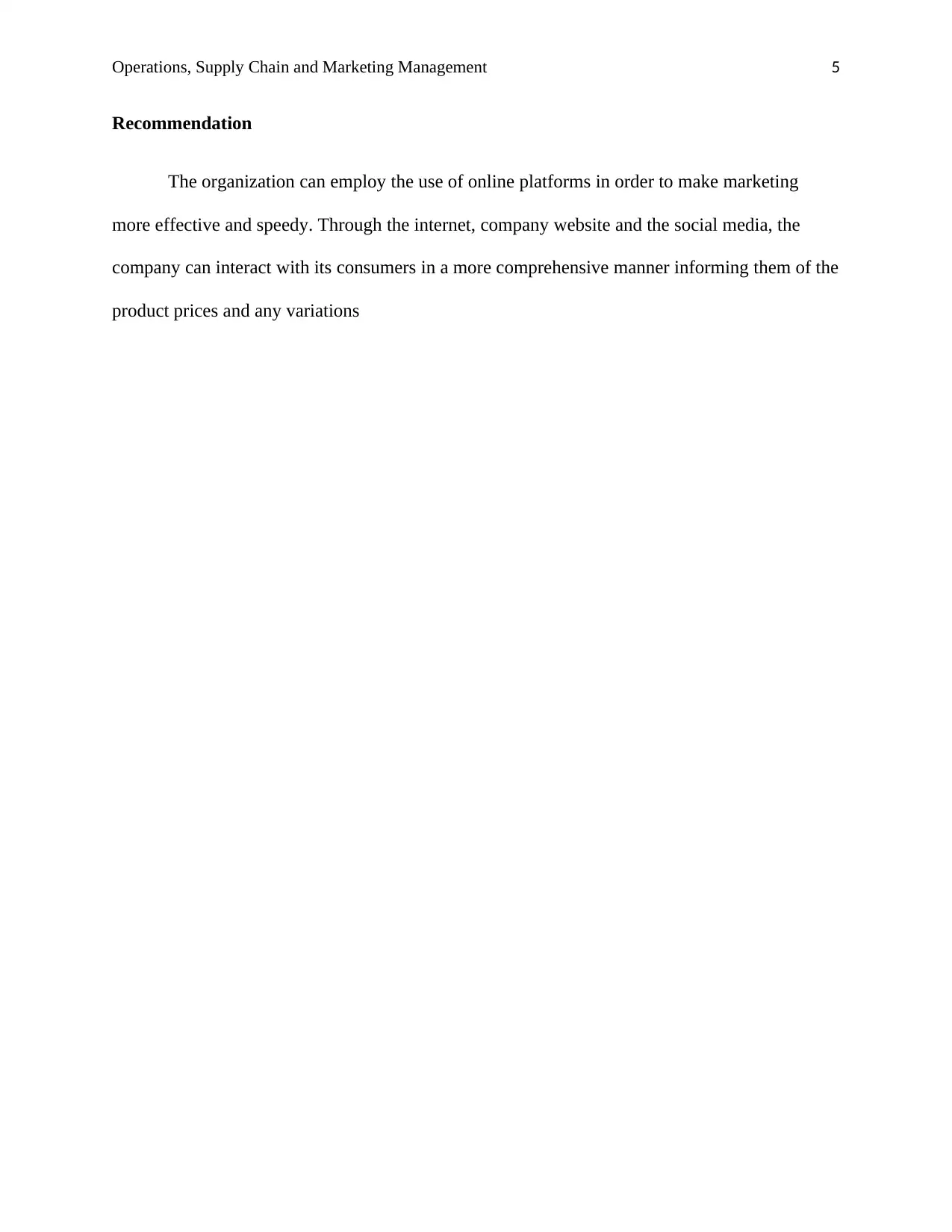
Operations, Supply Chain and Marketing Management 5
Recommendation
The organization can employ the use of online platforms in order to make marketing
more effective and speedy. Through the internet, company website and the social media, the
company can interact with its consumers in a more comprehensive manner informing them of the
product prices and any variations
Recommendation
The organization can employ the use of online platforms in order to make marketing
more effective and speedy. Through the internet, company website and the social media, the
company can interact with its consumers in a more comprehensive manner informing them of the
product prices and any variations
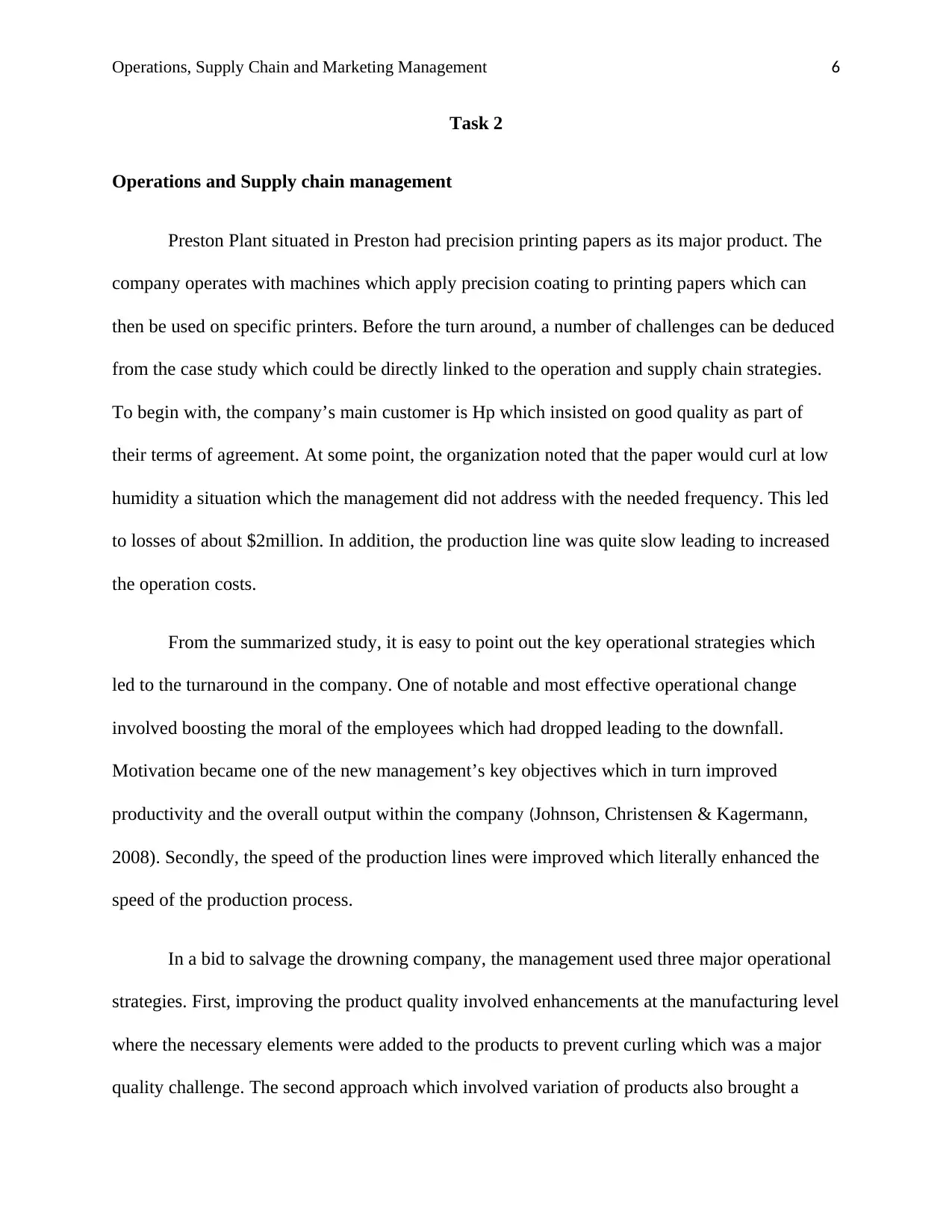
Operations, Supply Chain and Marketing Management 6
Task 2
Operations and Supply chain management
Preston Plant situated in Preston had precision printing papers as its major product. The
company operates with machines which apply precision coating to printing papers which can
then be used on specific printers. Before the turn around, a number of challenges can be deduced
from the case study which could be directly linked to the operation and supply chain strategies.
To begin with, the company’s main customer is Hp which insisted on good quality as part of
their terms of agreement. At some point, the organization noted that the paper would curl at low
humidity a situation which the management did not address with the needed frequency. This led
to losses of about $2million. In addition, the production line was quite slow leading to increased
the operation costs.
From the summarized study, it is easy to point out the key operational strategies which
led to the turnaround in the company. One of notable and most effective operational change
involved boosting the moral of the employees which had dropped leading to the downfall.
Motivation became one of the new management’s key objectives which in turn improved
productivity and the overall output within the company (Johnson, Christensen & Kagermann,
2008). Secondly, the speed of the production lines were improved which literally enhanced the
speed of the production process.
In a bid to salvage the drowning company, the management used three major operational
strategies. First, improving the product quality involved enhancements at the manufacturing level
where the necessary elements were added to the products to prevent curling which was a major
quality challenge. The second approach which involved variation of products also brought a
Task 2
Operations and Supply chain management
Preston Plant situated in Preston had precision printing papers as its major product. The
company operates with machines which apply precision coating to printing papers which can
then be used on specific printers. Before the turn around, a number of challenges can be deduced
from the case study which could be directly linked to the operation and supply chain strategies.
To begin with, the company’s main customer is Hp which insisted on good quality as part of
their terms of agreement. At some point, the organization noted that the paper would curl at low
humidity a situation which the management did not address with the needed frequency. This led
to losses of about $2million. In addition, the production line was quite slow leading to increased
the operation costs.
From the summarized study, it is easy to point out the key operational strategies which
led to the turnaround in the company. One of notable and most effective operational change
involved boosting the moral of the employees which had dropped leading to the downfall.
Motivation became one of the new management’s key objectives which in turn improved
productivity and the overall output within the company (Johnson, Christensen & Kagermann,
2008). Secondly, the speed of the production lines were improved which literally enhanced the
speed of the production process.
In a bid to salvage the drowning company, the management used three major operational
strategies. First, improving the product quality involved enhancements at the manufacturing level
where the necessary elements were added to the products to prevent curling which was a major
quality challenge. The second approach which involved variation of products also brought a
⊘ This is a preview!⊘
Do you want full access?
Subscribe today to unlock all pages.

Trusted by 1+ million students worldwide
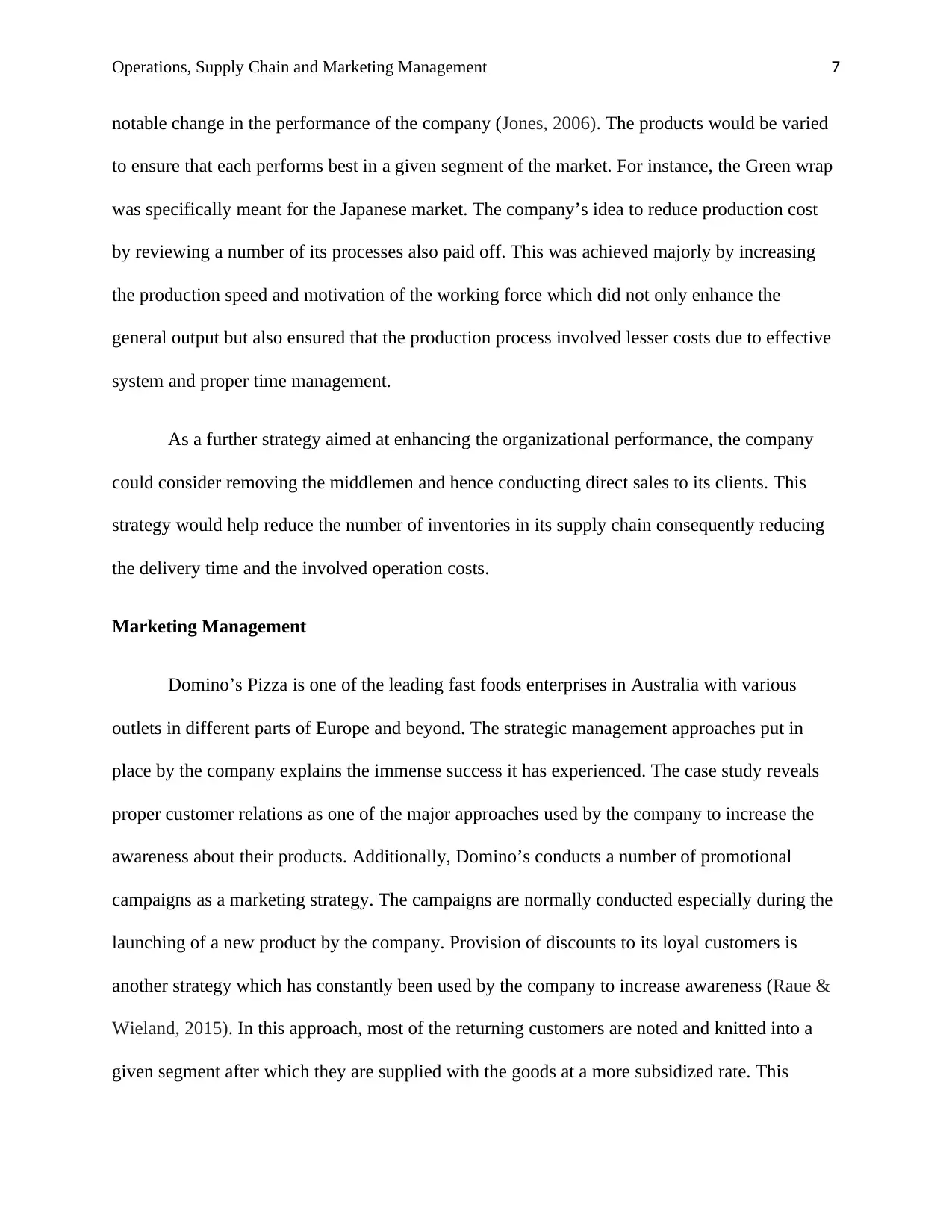
Operations, Supply Chain and Marketing Management 7
notable change in the performance of the company (Jones, 2006). The products would be varied
to ensure that each performs best in a given segment of the market. For instance, the Green wrap
was specifically meant for the Japanese market. The company’s idea to reduce production cost
by reviewing a number of its processes also paid off. This was achieved majorly by increasing
the production speed and motivation of the working force which did not only enhance the
general output but also ensured that the production process involved lesser costs due to effective
system and proper time management.
As a further strategy aimed at enhancing the organizational performance, the company
could consider removing the middlemen and hence conducting direct sales to its clients. This
strategy would help reduce the number of inventories in its supply chain consequently reducing
the delivery time and the involved operation costs.
Marketing Management
Domino’s Pizza is one of the leading fast foods enterprises in Australia with various
outlets in different parts of Europe and beyond. The strategic management approaches put in
place by the company explains the immense success it has experienced. The case study reveals
proper customer relations as one of the major approaches used by the company to increase the
awareness about their products. Additionally, Domino’s conducts a number of promotional
campaigns as a marketing strategy. The campaigns are normally conducted especially during the
launching of a new product by the company. Provision of discounts to its loyal customers is
another strategy which has constantly been used by the company to increase awareness (Raue &
Wieland, 2015). In this approach, most of the returning customers are noted and knitted into a
given segment after which they are supplied with the goods at a more subsidized rate. This
notable change in the performance of the company (Jones, 2006). The products would be varied
to ensure that each performs best in a given segment of the market. For instance, the Green wrap
was specifically meant for the Japanese market. The company’s idea to reduce production cost
by reviewing a number of its processes also paid off. This was achieved majorly by increasing
the production speed and motivation of the working force which did not only enhance the
general output but also ensured that the production process involved lesser costs due to effective
system and proper time management.
As a further strategy aimed at enhancing the organizational performance, the company
could consider removing the middlemen and hence conducting direct sales to its clients. This
strategy would help reduce the number of inventories in its supply chain consequently reducing
the delivery time and the involved operation costs.
Marketing Management
Domino’s Pizza is one of the leading fast foods enterprises in Australia with various
outlets in different parts of Europe and beyond. The strategic management approaches put in
place by the company explains the immense success it has experienced. The case study reveals
proper customer relations as one of the major approaches used by the company to increase the
awareness about their products. Additionally, Domino’s conducts a number of promotional
campaigns as a marketing strategy. The campaigns are normally conducted especially during the
launching of a new product by the company. Provision of discounts to its loyal customers is
another strategy which has constantly been used by the company to increase awareness (Raue &
Wieland, 2015). In this approach, most of the returning customers are noted and knitted into a
given segment after which they are supplied with the goods at a more subsidized rate. This
Paraphrase This Document
Need a fresh take? Get an instant paraphrase of this document with our AI Paraphraser
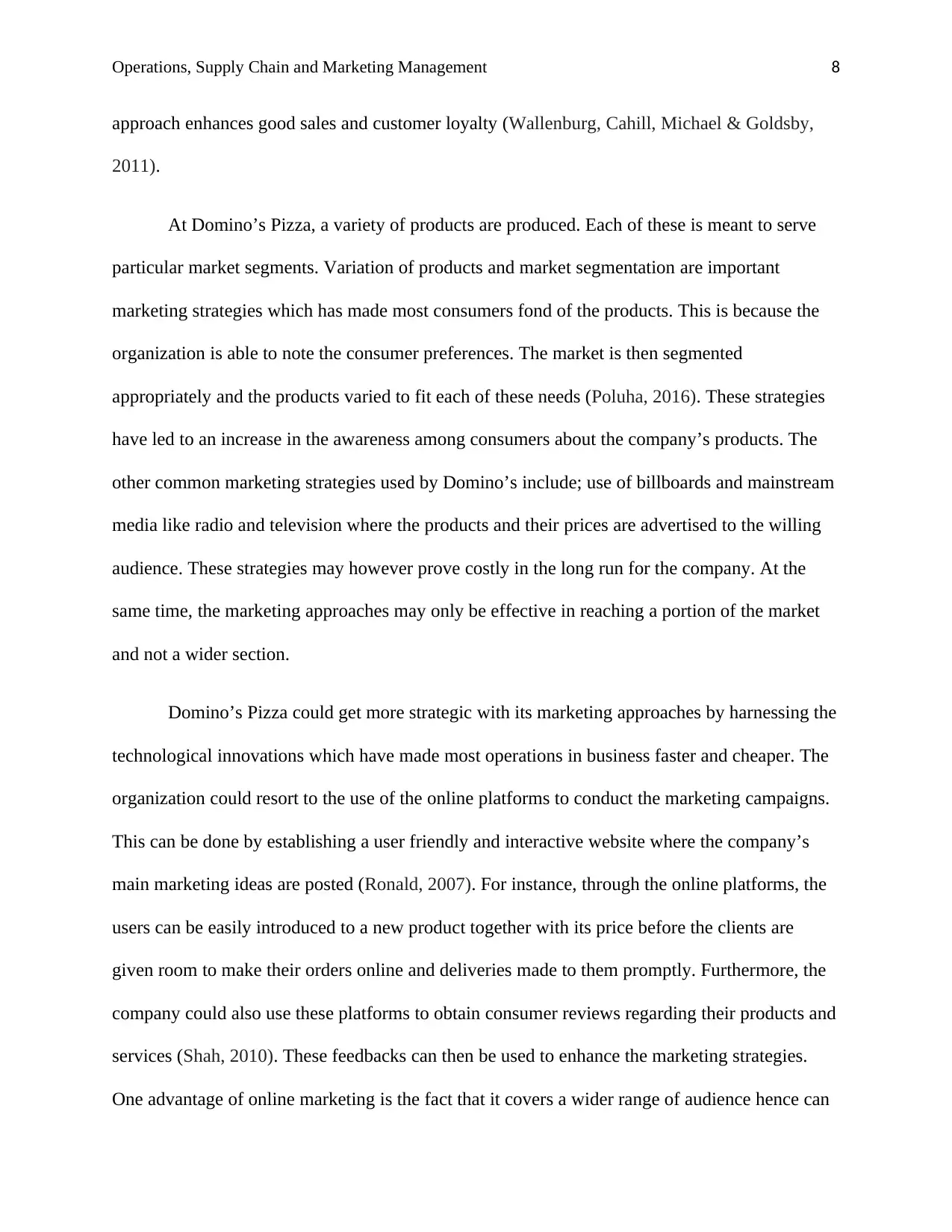
Operations, Supply Chain and Marketing Management 8
approach enhances good sales and customer loyalty (Wallenburg, Cahill, Michael & Goldsby,
2011).
At Domino’s Pizza, a variety of products are produced. Each of these is meant to serve
particular market segments. Variation of products and market segmentation are important
marketing strategies which has made most consumers fond of the products. This is because the
organization is able to note the consumer preferences. The market is then segmented
appropriately and the products varied to fit each of these needs (Poluha, 2016). These strategies
have led to an increase in the awareness among consumers about the company’s products. The
other common marketing strategies used by Domino’s include; use of billboards and mainstream
media like radio and television where the products and their prices are advertised to the willing
audience. These strategies may however prove costly in the long run for the company. At the
same time, the marketing approaches may only be effective in reaching a portion of the market
and not a wider section.
Domino’s Pizza could get more strategic with its marketing approaches by harnessing the
technological innovations which have made most operations in business faster and cheaper. The
organization could resort to the use of the online platforms to conduct the marketing campaigns.
This can be done by establishing a user friendly and interactive website where the company’s
main marketing ideas are posted (Ronald, 2007). For instance, through the online platforms, the
users can be easily introduced to a new product together with its price before the clients are
given room to make their orders online and deliveries made to them promptly. Furthermore, the
company could also use these platforms to obtain consumer reviews regarding their products and
services (Shah, 2010). These feedbacks can then be used to enhance the marketing strategies.
One advantage of online marketing is the fact that it covers a wider range of audience hence can
approach enhances good sales and customer loyalty (Wallenburg, Cahill, Michael & Goldsby,
2011).
At Domino’s Pizza, a variety of products are produced. Each of these is meant to serve
particular market segments. Variation of products and market segmentation are important
marketing strategies which has made most consumers fond of the products. This is because the
organization is able to note the consumer preferences. The market is then segmented
appropriately and the products varied to fit each of these needs (Poluha, 2016). These strategies
have led to an increase in the awareness among consumers about the company’s products. The
other common marketing strategies used by Domino’s include; use of billboards and mainstream
media like radio and television where the products and their prices are advertised to the willing
audience. These strategies may however prove costly in the long run for the company. At the
same time, the marketing approaches may only be effective in reaching a portion of the market
and not a wider section.
Domino’s Pizza could get more strategic with its marketing approaches by harnessing the
technological innovations which have made most operations in business faster and cheaper. The
organization could resort to the use of the online platforms to conduct the marketing campaigns.
This can be done by establishing a user friendly and interactive website where the company’s
main marketing ideas are posted (Ronald, 2007). For instance, through the online platforms, the
users can be easily introduced to a new product together with its price before the clients are
given room to make their orders online and deliveries made to them promptly. Furthermore, the
company could also use these platforms to obtain consumer reviews regarding their products and
services (Shah, 2010). These feedbacks can then be used to enhance the marketing strategies.
One advantage of online marketing is the fact that it covers a wider range of audience hence can
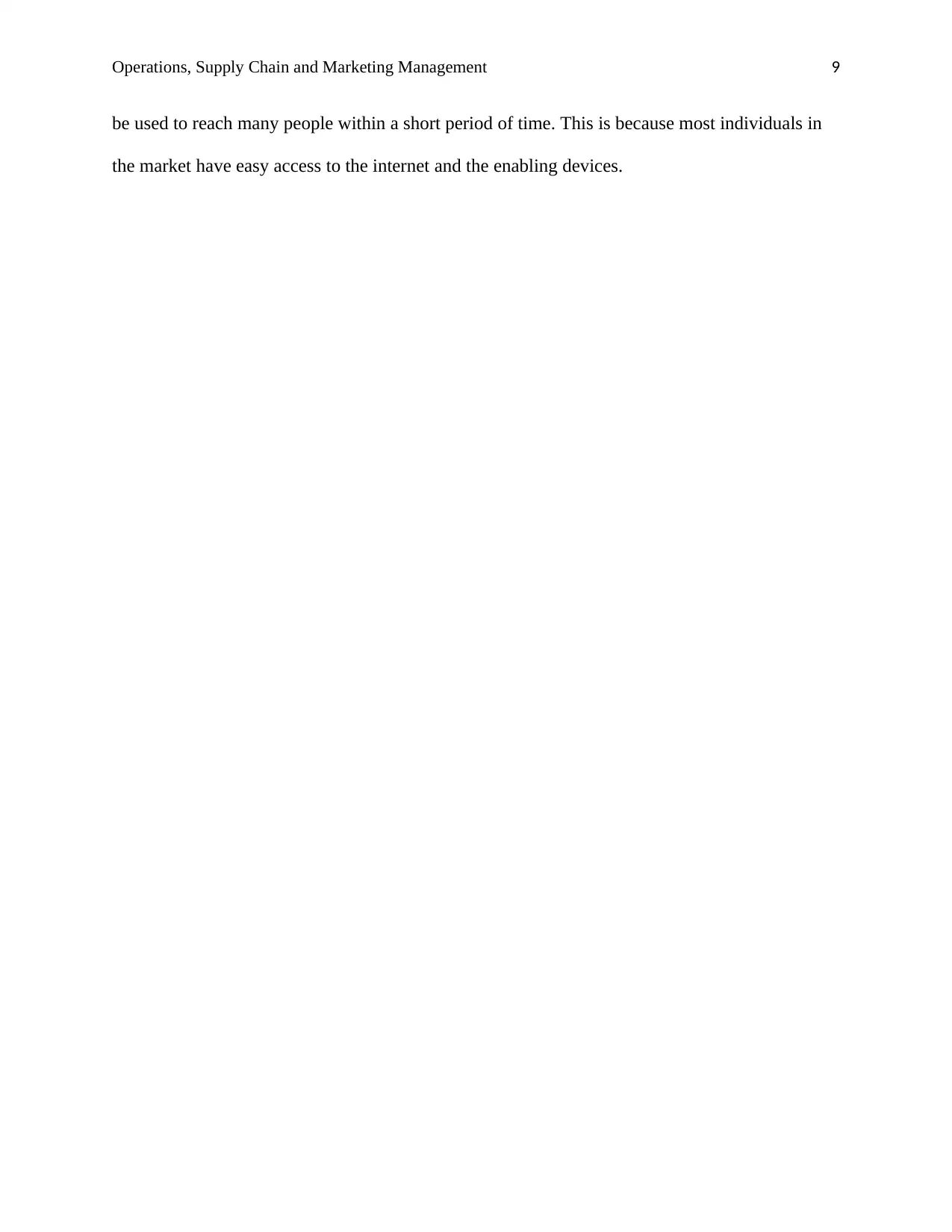
Operations, Supply Chain and Marketing Management 9
be used to reach many people within a short period of time. This is because most individuals in
the market have easy access to the internet and the enabling devices.
be used to reach many people within a short period of time. This is because most individuals in
the market have easy access to the internet and the enabling devices.
⊘ This is a preview!⊘
Do you want full access?
Subscribe today to unlock all pages.

Trusted by 1+ million students worldwide
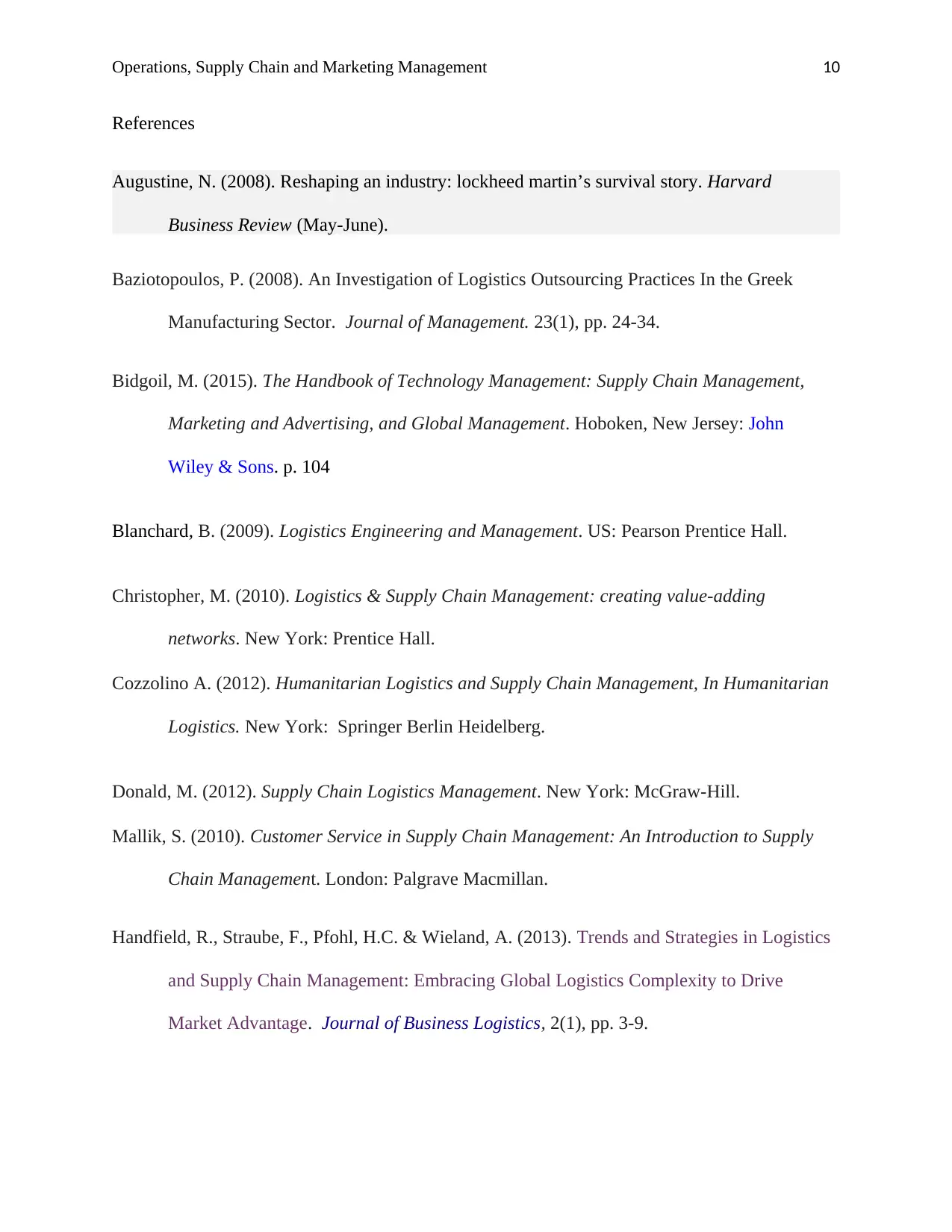
Operations, Supply Chain and Marketing Management 10
References
Augustine, N. (2008). Reshaping an industry: lockheed martin’s survival story. Harvard
Business Review (May-June).
Baziotopoulos, P. (2008). An Investigation of Logistics Outsourcing Practices In the Greek
Manufacturing Sector. Journal of Management. 23(1), pp. 24-34.
Bidgoil, M. (2015). The Handbook of Technology Management: Supply Chain Management,
Marketing and Advertising, and Global Management. Hoboken, New Jersey: John
Wiley & Sons. p. 104
Blanchard, B. (2009). Logistics Engineering and Management. US: Pearson Prentice Hall.
Christopher, M. (2010). Logistics & Supply Chain Management: creating value-adding
networks. New York: Prentice Hall.
Cozzolino A. (2012). Humanitarian Logistics and Supply Chain Management, In Humanitarian
Logistics. New York: Springer Berlin Heidelberg.
Donald, M. (2012). Supply Chain Logistics Management. New York: McGraw-Hill.
Mallik, S. (2010). Customer Service in Supply Chain Management: An Introduction to Supply
Chain Management. London: Palgrave Macmillan.
Handfield, R., Straube, F., Pfohl, H.C. & Wieland, A. (2013). Trends and Strategies in Logistics
and Supply Chain Management: Embracing Global Logistics Complexity to Drive
Market Advantage. Journal of Business Logistics, 2(1), pp. 3-9.
References
Augustine, N. (2008). Reshaping an industry: lockheed martin’s survival story. Harvard
Business Review (May-June).
Baziotopoulos, P. (2008). An Investigation of Logistics Outsourcing Practices In the Greek
Manufacturing Sector. Journal of Management. 23(1), pp. 24-34.
Bidgoil, M. (2015). The Handbook of Technology Management: Supply Chain Management,
Marketing and Advertising, and Global Management. Hoboken, New Jersey: John
Wiley & Sons. p. 104
Blanchard, B. (2009). Logistics Engineering and Management. US: Pearson Prentice Hall.
Christopher, M. (2010). Logistics & Supply Chain Management: creating value-adding
networks. New York: Prentice Hall.
Cozzolino A. (2012). Humanitarian Logistics and Supply Chain Management, In Humanitarian
Logistics. New York: Springer Berlin Heidelberg.
Donald, M. (2012). Supply Chain Logistics Management. New York: McGraw-Hill.
Mallik, S. (2010). Customer Service in Supply Chain Management: An Introduction to Supply
Chain Management. London: Palgrave Macmillan.
Handfield, R., Straube, F., Pfohl, H.C. & Wieland, A. (2013). Trends and Strategies in Logistics
and Supply Chain Management: Embracing Global Logistics Complexity to Drive
Market Advantage. Journal of Business Logistics, 2(1), pp. 3-9.
Paraphrase This Document
Need a fresh take? Get an instant paraphrase of this document with our AI Paraphraser
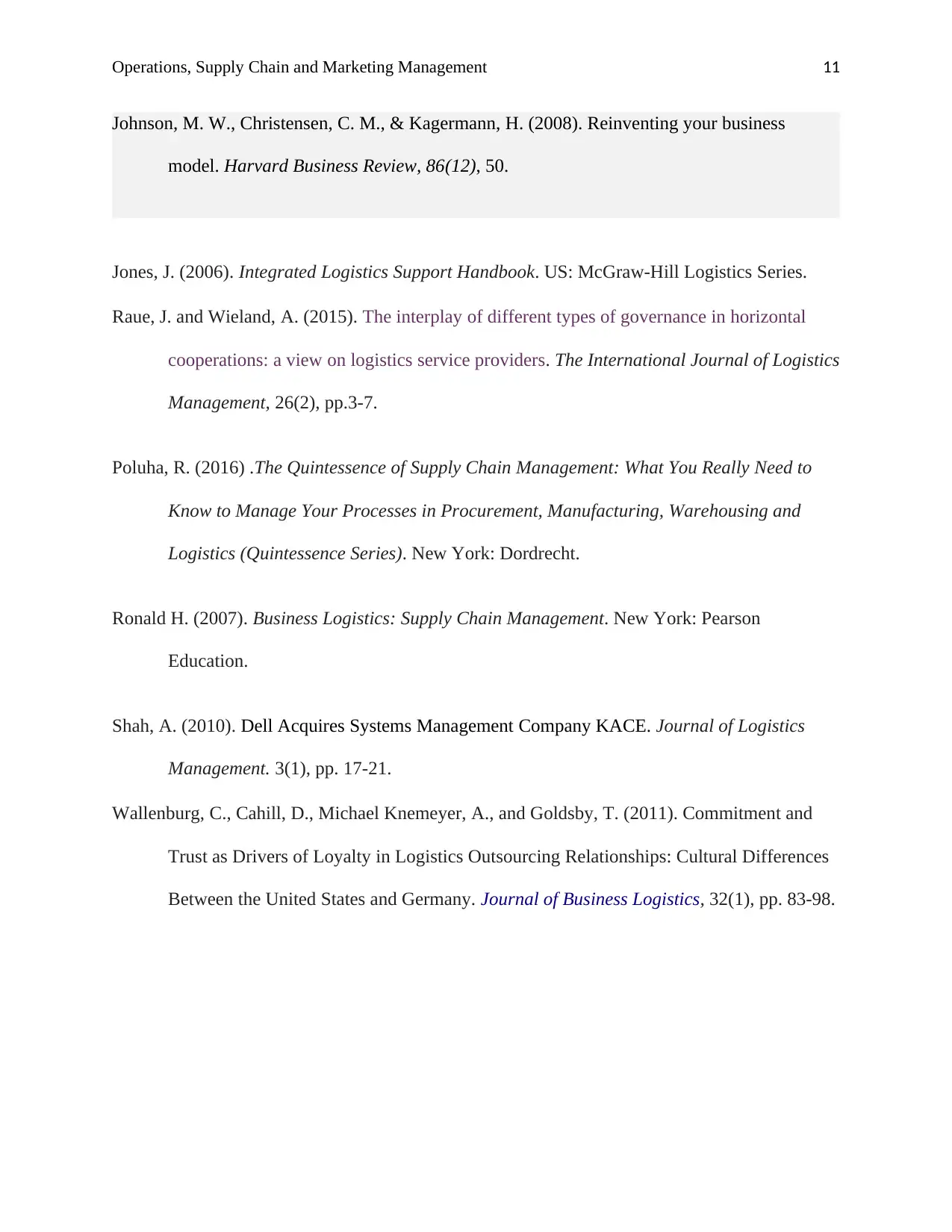
Operations, Supply Chain and Marketing Management 11
Johnson, M. W., Christensen, C. M., & Kagermann, H. (2008). Reinventing your business
model. Harvard Business Review, 86(12), 50.
Jones, J. (2006). Integrated Logistics Support Handbook. US: McGraw-Hill Logistics Series.
Raue, J. and Wieland, A. (2015). The interplay of different types of governance in horizontal
cooperations: a view on logistics service providers. The International Journal of Logistics
Management, 26(2), pp.3-7.
Poluha, R. (2016) .The Quintessence of Supply Chain Management: What You Really Need to
Know to Manage Your Processes in Procurement, Manufacturing, Warehousing and
Logistics (Quintessence Series). New York: Dordrecht.
Ronald H. (2007). Business Logistics: Supply Chain Management. New York: Pearson
Education.
Shah, A. (2010). Dell Acquires Systems Management Company KACE. Journal of Logistics
Management. 3(1), pp. 17-21.
Wallenburg, C., Cahill, D., Michael Knemeyer, A., and Goldsby, T. (2011). Commitment and
Trust as Drivers of Loyalty in Logistics Outsourcing Relationships: Cultural Differences
Between the United States and Germany. Journal of Business Logistics, 32(1), pp. 83-98.
Johnson, M. W., Christensen, C. M., & Kagermann, H. (2008). Reinventing your business
model. Harvard Business Review, 86(12), 50.
Jones, J. (2006). Integrated Logistics Support Handbook. US: McGraw-Hill Logistics Series.
Raue, J. and Wieland, A. (2015). The interplay of different types of governance in horizontal
cooperations: a view on logistics service providers. The International Journal of Logistics
Management, 26(2), pp.3-7.
Poluha, R. (2016) .The Quintessence of Supply Chain Management: What You Really Need to
Know to Manage Your Processes in Procurement, Manufacturing, Warehousing and
Logistics (Quintessence Series). New York: Dordrecht.
Ronald H. (2007). Business Logistics: Supply Chain Management. New York: Pearson
Education.
Shah, A. (2010). Dell Acquires Systems Management Company KACE. Journal of Logistics
Management. 3(1), pp. 17-21.
Wallenburg, C., Cahill, D., Michael Knemeyer, A., and Goldsby, T. (2011). Commitment and
Trust as Drivers of Loyalty in Logistics Outsourcing Relationships: Cultural Differences
Between the United States and Germany. Journal of Business Logistics, 32(1), pp. 83-98.

Operations, Supply Chain and Marketing Management 12
⊘ This is a preview!⊘
Do you want full access?
Subscribe today to unlock all pages.

Trusted by 1+ million students worldwide
1 out of 12
Related Documents
Your All-in-One AI-Powered Toolkit for Academic Success.
+13062052269
info@desklib.com
Available 24*7 on WhatsApp / Email
![[object Object]](/_next/static/media/star-bottom.7253800d.svg)
Unlock your academic potential
Copyright © 2020–2025 A2Z Services. All Rights Reserved. Developed and managed by ZUCOL.





